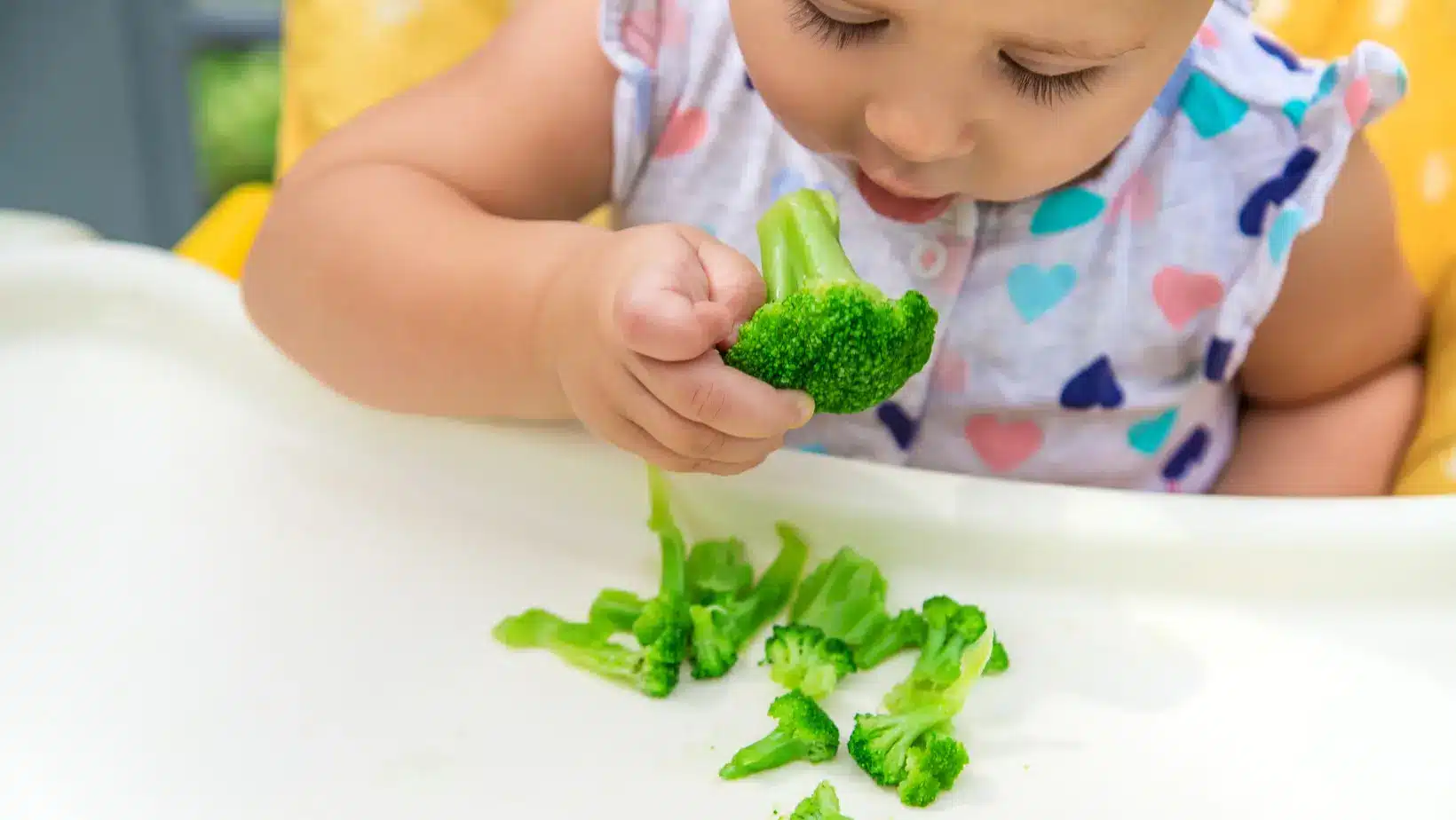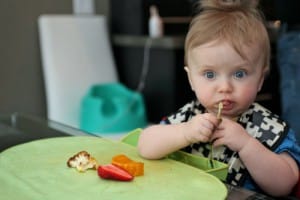The term baby-led weaning, or BLW, appeared over the past years, and it designates another way of giving solid foods to a baby. It’s an approach, not a technique. This feeding method consists of offering pieces of food to the baby early in life. This should be at the table, getting them used to touch, to reach for it, to bring it to their mouth by themselves, to explore different textures and meet their own appetite needs.
The concept ignores purées as normally it includes less than 10% of purées or foods given with a spoon. This means that this approach does not completely exclude purées, but only as needed. The child fees themselves by grabbing pieces of food with their fingers, pinching them and then bringing them to their mouth.
Six points provide an overview of BLW: the food is offered in pieces, the meals are balanced and similar to the rest of the family, the development of skills is based on the baby’s pace, the signs of hunger and satiety guide quantities, the meals are taken as a family and the baby eats alone without help.
This approach comes from New Zealand and the UK, but here in Canada, we do not have in-depth data about the topic. The province of Alberta and New Zealand do not recommend BLW.
To date, Health Canada and the Canadian Association of Pediatrists state that the baby can take small pieces of food starting from 9 months of age, but no earlier than that. There is not a lot of research that documents baby-led weaning. Social networks are part of parents’ information sources and they are rarely credible, safe and good to use. However, the BLISS study, published in 2015, suggests a modified baby led weaning approach that suggests a mix of pieces of food with the addition of purées to properly meet the baby’s needs until they can eat like their parents.
Some health professionals, such as occupational therapists, can explain to you how purées can help the baby’s tongue movement to learn how to accept different textures to better handle pieces of food that they have to chew and then swallow.
Reasons Stated by Parents to Start Baby-Led Weaning
The reasons stated by parents to start baby-led weaning vary enormously and can be strange at times:
- they can explore a range of colours and textures;
- allows them to smell the food before eating it;
- develops motor skills and coordination for their physical development (rapid progression of fine motor skills);
- can help self-confidence (positive attitude towards discovering foods);
- can contribute to the development of chewing muscles and help digestion;
- gives them a feeling of independence;
- family organisation for easier meals (everyone eats the same thing);
- can diminish the costs of foods specific to the baby;
- can reduce obesity (pace dictated by the child, respecting satiety);
- being less averse to different textures;
- can help the development of the child’s autonomy.
To use baby led weaning with pieces of food, you have to note the physical signs that the baby is ready (see the entry on Baby’s Diet).
BLW only starts after six months, and the baby must be able to remain seated in their chair during family meals without help. The baby must be born at term and in good health with good full development. The baby must also be able to turn their head from left to right and up and down, and finally, they are able to bring food to their mouth. Parents can then give them pieces of food from each food group to ensure that they eat a bit of everything and meet their nutritional needs. The child must be able to pick up the food and bring it to their mouth.
Research Results About BLW
The few studies that have been done on the topic leave much room for interpretation and the unknown. These were done on small cohorts of babies and didn’t provide clear information on when to start this approach, the real benefits, safe BLW techniques and the potential inconveniences of this diet.
Based on completed studies, in families that use BLW, it seems the parents are often highly educated, and the mother breastfeeds their baby longer too. A severe lack of information and research in the scientific literature about the topic remains today. Generally, we can’t advise this diet, lacking the fine details about prevention associated with this approach.
The Risks of Baby-Led Weaning
The risks of baby-led weaning should be considered when deciding how to feed your baby.
Founded or unfounded, to be documented in the future:
- delays in the growth curve (weight and height);
- risk of choking;
- lack of iron sources (can provoke anemia), zinc and folates (B-12). Cereals enriched with iron aren’t eaten by hand and aren’t given as frequently to a baby in this approach. Health Canada recommends including iron sources during each meal;
- fruits and vegetables are often the first food introduced in BLW, which increases the risk of anemia;
- the food quality is lower since parents eat foods with more salt, sugar and fat;
- increase in the gag reflex and risk of choking (modification of the pharyngeal reflex during the first year of life for newborns), but by always respecting precautions this diminishes the risk.
The conclusions of the BLISS study seem to indicate that the ideal approach is to combine both food pieces and spoon-fed purée, as you can avoid many potential inconveniences of a BLW approach. With certain foods that aren’t solid, like baby cereals enriched with iron and yogurt (it also has added iron), you meet specific needs. You can also allow the baby to handle the spoon on their own. According to the 2022 update, it is not appropriate to perform BLW with a baby who has a lot of facial eczema, as the damaged skin could increase the impact of allergens.
Of course, you have to avoid large pieces due to risks of choking. Even if you present the food in small pieces, the baby might have a gag reflex. This isn’t choking, but associated with the maturity of their nervous system and a reaction to poor chewing of food that ends up in their throat. You have to remain alert and offer safe foods that don’t hinder their chewing and swallowing. This is why it’s preferable:
- to avoid foods that are hard (pieces of apple, even if they’re often suggested in web forums, gum, candy, fresh vegetables, dried fruits, chewable vitamins), round or sticky (bread, marshmallows);
- that hard food is blanched before given to the baby. If we take a whole carrot, for example, it must be sufficiently heated so when parents bite it can easily crush it against their palate;
- to not forget foods rich in iron. Meats and poultry cooked in a crockpot sliced or balled, poached fish or homemade nuggets, tofu sticks or as a dip, legumes like hummus, eggs in an omelette or hard-boiled and cut. Other foods enriched with baby cereal with iron like crepes, waffles and cookies. You can give them avocado, bananas, potatoes and broccoli, but they don’t have iron. So why not roll a banana in baby cereal? The baby will get iron and eat by themselves;
- that the food surpasses the bottom and top of the baby’s hand when they hold it, in the form of strips or slices;
- that the baby is sitting properly in their chair;
- that the baby is always supervised, and those monitoring them must avoid distractions;
- to never place pieces of food in the baby’s mouth. Let them do it;
- to go progressively respecting the baby’s abilities, which will develop over time. Around 7 or 8 months, they will be able to pinch the food with three fingers. Around nine months, pinch it with two fingers. Add little pieces the size of a die, like a crushed blueberry. Around 12 months, their chewing is more effective, meaning you can offer crunchier solid foods like dry cereal;
- to vary the foods to get all food groups and different textures;
- to be ready to perform airway clearance techniques in case of choking.
Possible Inconveniences of BLW
When we use baby-led weaning, you have to be patient and vigilant because meals are often 50% longer. The baby will play with the food, crush it in their hands or throw it on the ground. You will wonder if they have eaten enough of everything and if they consumed enough nutrients for their development.
In conclusion, other research and experiments about BLW are ongoing, and I will update this information for you as scientific developments are released. Most health professionals are open-minded about baby-led weaning, but have specific reserves associated with the inconveniences for the baby over the medium- and long-term. Only through future research will we have additional data to understand the approach better. The ongoing BLISS study can undoubtedly lead to more information for our currently limited library of knowledge about BLW.
We hope this entry has taught you more about this approach.
Do you need more information? Please watch the video about Baby Led Weaning, or BLW (in french) filmed with the occupational therapist Catherine Cusson.
Marie Fortier
The Baby Expert
Updated on January 2023.



